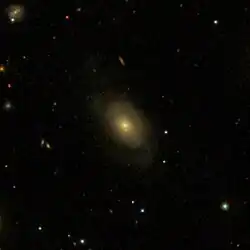| NGC 900 | |
|---|---|
 SDSS image of NGC 900 | |
| Observation data (J2000 epoch) | |
| Constellation | Aries |
| Right ascension | 02h 23m 32.18058s[1] |
| Declination | +26° 30′ 41.6759″[1] |
| Redshift | 0.03254[2] |
| Heliocentric radial velocity | 9596 km/s[2] |
| Distance | 428.1 Mly (131.25 Mpc)[3] |
| Apparent magnitude (B) | 15.0[2] |
| Characteristics | |
| Type | S0[2] |
| Other designations | |
| UGC 1843, MCG +04-06-020, PGC 9079[2] | |
NGC 900 is a lenticular galaxy located in the constellation Aries about 430 million light-years[3] from the Milky Way. It was discovered by the German astronomer Albert Marth in 1864.[4][5][6][7]
See also
References
- 1 2 Brown, A. G. A.; et al. (Gaia collaboration) (August 2018). "Gaia Data Release 2: Summary of the contents and survey properties". Astronomy & Astrophysics. 616. A1. arXiv:1804.09365. Bibcode:2018A&A...616A...1G. doi:10.1051/0004-6361/201833051.
- 1 2 3 4 5 "NGC 900". SIMBAD. Centre de données astronomiques de Strasbourg. Retrieved 2020-05-25.
- 1 2 Crook, Aidan C.; Huchra, John P.; Martimbeau, Nathalie; Masters, Karen L.; Jarrett, Tom; Macri, Lucas M. (2007). "Groups of Galaxies in the Two Micron All Sky Redshift Survey". The Astrophysical Journal. 655 (2): 790–813. arXiv:astro-ph/0610732. Bibcode:2007ApJ...655..790C. doi:10.1086/510201. S2CID 11672751.
- ↑ "New General Catalog Objects: NGC 900 - 949". cseligman.com. Retrieved 2020-03-19.
- ↑ "Your NED Search Results". ned.ipac.caltech.edu. Retrieved 2020-03-19.
- ↑ "Revised NGC Data for NGC 900". spider.seds.org. Retrieved 2020-03-19.
- ↑ Ford, Dominic. "The galaxy NGC 900 - In-The-Sky.org". in-the-sky.org. Retrieved 2020-03-19.
External links
 Media related to NGC 900 at Wikimedia Commons
Media related to NGC 900 at Wikimedia Commons
This article is issued from Wikipedia. The text is licensed under Creative Commons - Attribution - Sharealike. Additional terms may apply for the media files.